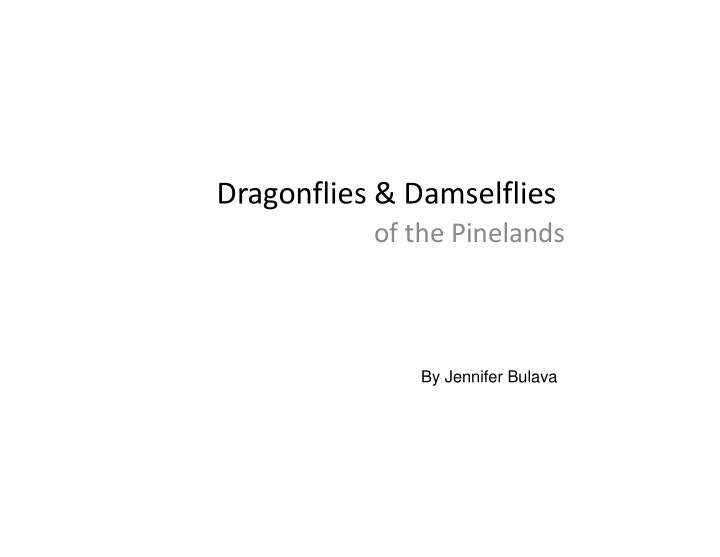



Dragonflies & Damselflies of the Pinelands By Jennifer Bulava
Dragonflies and Damselfies • Kingdom: Animals – Phylum: Invertebrates • Class: Insects – Order: Odonata • Odonata derived from the Greek "odonto ‐ " , meaning tooth, referring to the strong teeth found on the mandibles of most adults • Dragonflies and Damselflies known collectively as odonates • 4 wings move independently of one another • Found in warm months, normally close to water with nearby vegetation (5,900 species world ‐ wide)
Ancient Insects • Fast fact: Giant dragonflies from the Paleozoic Era (over 300 million years ago) were the largest insects of all time! • 28 inch wingspan • 17 inch body length • Found in North America
Dragonflies Damselflies • Wings folded together • Wings held flat out to above body at rest * the side at rest • Generally smaller • Generally larger, more (under 2 inches) powerful fliers • Wings of similar size • Hindwing broader at and shape the base than forewing • Eyes smaller and • Eyes large, close normally separated together * Spreadwings hold their wings above their bodies but spread apart
Dragonflies • Highly admired by Japanese for 1,000’s of years, heavily used in poetry. Entire museums and sanctuaries for dragonflies in Japan! • In North America and Britain, sometimes mistakenly called “devil’s darning needles” and “horsestingers” • NJ :3 rd smallest state by area but ranks 4 th for longest list of dragonfly & damselfly species of any state, behind Texas, Virginia, and New York.
Odonates as Beneficial Predators • Adults eat flying insects • Nymphs eat aquatic prey (anything smaller than them) • Adults & nymphs consume large quantities of insect pests, especially flies & mosquitoes!
• All lay their eggs in or near the water. – Some lay eggs directly on the water (emeralds, skimmers, spiketails) – Some slice open vegetation and insert eggs inside (darners, spreadwings) – Some attach eggs to the outside of plants – Some species hatch within 5 ‐ 10 days (especially those in temporary pools) while others can take several months.
• Nymph Stage: Aquatic – Modified lower lip with two spiny barbs at the end for capturing prey – Top invertebrate aquatic predators in most water bodies and consume huge amounts of mosquito larvae
• Metamorphosis to Adult – End of nymph stage, climbs out of water and attaches tightly to vegetation – Swallows air which causes the shell to swell and eventually split open along the top of the thorax – Slowly emerges from its “shell,” during this process the insect is helpless – The legs harden and the abdomen inflates and explants to its full length. The wings are pumped full of blood and eventually stretch and harden
• Newly emerged adults are called teneral – Generally pale and unmarked – Body and wing markings take 1 ‐ 2 days to fully develop. – At this point they can forage but cannot mate
• Some dragonflies perch: (clubtails, whitetail, pondhawk, corporals, white face, meadowhawks, skimmers, pennants) – Obelisk posture: a handstand ‐ like position that some odonates assume to prevent overheating on sunny days – The abdomen is raised until its tip points at the sun, minimizing the surface area exposed to sun – When sun is low in the sky, can raise/lower abdomen perpendicular to the sun’s rays, maximizing the area exposed to sun
• Some patrol: spiketails, river cruisers, dragonhunter, darners, emeralds, baskettails, gliders – While flying, some Saddlebags Gliders lower their abdomens into the shade provided by dark patches at the bases of their hindwings
• Territorial defenses – Territorial species develop more rapidly and produce larger adults than other non ‐ territorial species – Many adult male dragonflies establish and defend territories along the perimeter of a lake or stream. Females will mate only with males that hold a territory
Mating • Wheel position: unique among insects • Odonates of the same species have interlocking structures on the male claspers and female head that enables the wheel to be formed and made secure. • Flying in tandem, even while ovipositing, to prevent other males from mating with female
• Migratory Dragonflies – 14 species known in the Northeast (ex: Green darner, swamp darner, 12 ‐ spotted skimmer – Flights late July ‐ early October, the peak in Sept., following major geographic features – Mass swarms follow cold fronts – Likely requires multiple generations to reach their northern breeding grounds.
Threats to Odonates – water quality degradation – Development & removal of surrounding habitat • Soil erosion, silt loading, water temp and dissolved oxygen • Areas for feeding, mating, and shelter disappear – Alteration of natural stream flow • Dams, channelization – Removal of aquatic vegetation – Pesticides, runoff & other toxins – Excess groundwater removal
• Threatened, Endangered, & Special Concern – Over 30 spp in NJ, ___ in Pinelands • Report rare sightings on the DEP’s Endangered and Non ‐ game species website: • Rare Wildlife Sighting Report Form – http://www.state.nj.us/dep/fgw/ensp/rprtform.htm • www.njodes.com – http://www.njodes.com/njos/rare_bug_form.htm
• Dragonflies & Damselflies = Odonata • Adults & nymphs are beneficial predators of pests • Incomplete metamorphosis – Egg, nymph, adult • Can reposition themselves to regulate heat • Territorial Defenses (Males patrolling) • Migratory status: 14 species, mostly darners and saddlebags
Recommend
More recommend